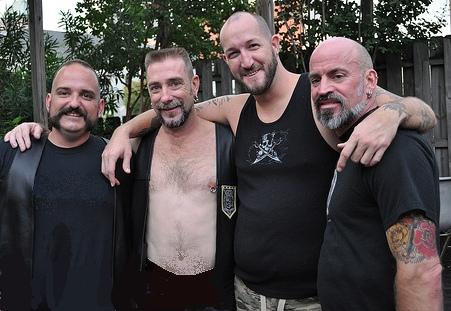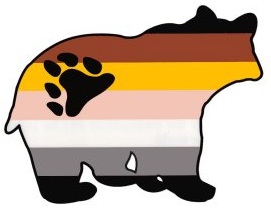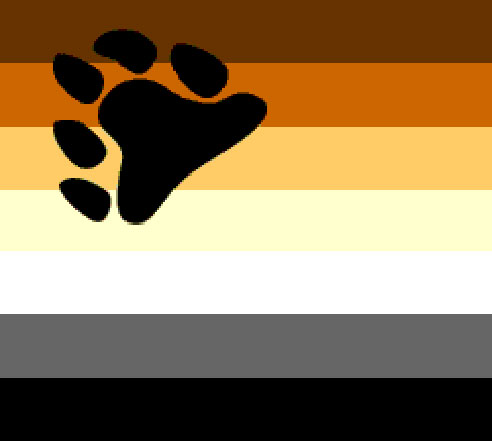|

HOME |
ABOUT | INDEX |
NEWS |
FACEBOOK |
CONTACT
BEARS
Hypermasculine | Big Hairy Guys
Bear Community
Bear is
LGBTQ slang for those in the Bear community or tribe, a
subculture in the gay/bisexual male communities and an
emerging subset of LGBTQ communities with events, codes
and culture-specific identity. It can also be used more
generically to describe a physical type. Bears tend to
have hairy bodies and facial hair. They are burly,
hefty, stocky, husky, rustic, and natural. Some are
heavy-set or muscular. Some are chubby. Some project an
image of working-class masculinity in their grooming and
appearance, though none of these are requirements or
unique indicators. Some Bears place importance on
presenting a hypermasculine image and may shun
interaction with, and even disdain, men who exhibit
effeminacy.



The Bear
concept can function as an identity, an affiliation, and
an ideal to live up to, and there is ongoing debate in
Bear communities about what constitutes a Bear, however
a consensus exists that inclusion is an important part
of the Bear Community. Bears (also called ursines) are
almost always gay or bisexual men, although increasingly
transgender men (transmen) and those who shun labels for
gender and sexuality are also included within Bear
communities.
Provincetown Bear Week 2024: Real Wiener Fest
Bear Necessities: Insider Look at Atypical Gay Culture
Photos: Bears Comfortably at Home
Monty Python: Lumberjack Song
Go Bear Hunting: Provincetown
Bear Week 2023
Bears on the Beach in
Puerto Vallarta
Video: Rise of the Bears
Illustrations Celebrating Bellies and Bears
Brotherhood of the Bears
Mad Bear Pool Party in Torremolinos
Better This Way by Doug Strahm
Artwork: Thick and Muscular Bears
Bear World Magazine
Research: Physical, Behavioral and Psychological Traits
of Bears
Bear Hugs
Hyper Masculine
Gay Men
Bear in
LGBTQ communities (or tribes) is a metaphorical reference to the
animal of the same name with similar notable features.
These features include the animal's hairiness, its solid
proportions, and its physical power. The bear is both
fat and powerful, and the reconciliation of these two
qualities is at the heart of the Bear concept's appeal.
The Bear
Community can trace its emblematic origins to bikers and
lumberjacks. Bears are typically very similar in
appearance to the ideal of the North American lumberjack
or motorcycle gang member. A romantic conflation of
the bear and the lumberjack image and the biker image provides the Bear trope its metaphorical appeal.



Bear Culture 101
Reference Guide to Gay Bear Culture
Wikipedia: Gay Bear Culture
Jock, Otter, Bear, or Wolf?
Monty Python: Lumberjack Song
Bear World Magazine
Video: Rise of the Bears
Brotherhood of the Bears
Better This Way by Doug Strahm
Bear Hugs
Lumberjacks were romanticized and fetishised in gay
culture long before the arrival of the Bear concept, and
the Bear concept retains strong traces of this older
ideal. Lumberjacks appealed to gay men at aesthetic
levels but also for the fact that they were working
class, and for the fact that their isolation from urban
society (and hence from mainstream gay culture) opened
up a fantasy of both secrecy and liberation, within an
idyllic, rural, North American setting. These metaphors
also lend themselves to the idealization of natural
physical appearance and preferences over more glamorized
ones despite the convenience many bears may find living
in urban settings.



The
self-identification of gay men as Bears originated in
San Francisco in the 1980s as an outgrowth of gay biker
clubs like the Rainbow Motorcycle Club, and then later
the leather and "girth and mirth" communities. It was
created by men who felt that mainstream gay culture was
unwelcoming to men who did not fit a particular "twink"
body norm (hairless and young). Also, many gay men in
rural America never identified with the stereotypical
urban gay lifestyle, and went searching for an
alternative that more closely resembled the idealized
blue collar American male image.
Bear Culture 101
Reference Guide to Gay Bear Culture
Wikipedia: Gay Bear Culture
Jock, Otter, Bear, or Wolf?
Monty Python: Lumberjack Song
Bear World Magazine
Illustrations Celebrating Bellies and Bears
Video: Rise of the Bears
Brotherhood of the Bears
Better This Way by Doug Strahm



Bear Terminology
--Bear: Hairy/heavy
set gay man
--Grizzly: Hairy/heavy set outdoors
type gay man
--Bruin: Hairy/heavy
set athletic gay man
--Panda Bear: Hairy/heavy set Asian gay man
--Black Bear: Hairy/heavy set African American gay man
--Brown Bear: Hairy/heavy set Hispanic gay man
--Polar Bear: Hairy/heavy set silver, white or gray haired gay man
--Ginger Bear: Hairy/heavy set red haired gay man
--Berenstein
Bear: Hairy/heavy
set Jewish gay man
--Koala Bear: Hairy/heavy
set Australian gay man
--Honey
Badger: Hairy blonde gay man, typically not muscular or
heavy set
--Otter: Lean and hairy gay man
--Cub: Young hairy gay man
--Chaser: Non hairy man who likes hairy men
--Goldilocks: Heterosexual female in the company of bears
(fag hag)
--Ursula: Butch lesbians who participate in the bear culture
--Woof: Greeting used by bears




Bear Necessities: Insider Look at Atypical Gay Culture
Better This Way by Doug Strahm
Photos: Bears Comfortably at Home
Provincetown Bear Week 2024: Real Wiener Fest
Bears on the Beach in
Puerto Vallarta
Mad Bear Pool Party in Torremolinos
Monty Python: Lumberjack Song
Bear World Magazine
Video: Rise of the Bears
Photos: Beautiful Bears in Palm Springs
Brotherhood of the Bears
Artwork: Thick and Muscular Bears
Research: Physical, Behavioral sand Psychological Traits
of Bears

Traits of the
Bear Community
The Bear community exists as a subculture in reaction to
the larger gay community. It rejects the normative
idealized male beauty revered by mainstream gay men.
Studies indicate that Bears are more likely to be
hairier, heavier, and shorter than mainstream gay men.
They report wanting partners who were hairier and
heavier.
The gay community is ultimately a heterogeneous one with
many subgroups and subcultures. One such subculture is
comprised of gay and bisexual men who identify as Bears.
Bears self-present as having the “correct attitude”
towards their “naturally developing/aging” male bodies.
They consider “real” masculinity to include having
comfort with other men’s bodies and eschew the more
normative gay male body-model, one in which thinness,
youth, hairlessness, and muscularity are revered. They
favor instead a body-model that may be predetermined by
genetics, age, or heteronormative masculine beliefs,
preferring that men should weigh more and be hairier.
There are
many different subdivisions within the Bear community.
Men are categorized primarily by their hairiness, but
also by their weight, age, and ethnicity. Divisions
within the community may consist of: Grizzly Bears
(White, hairy, heavier men), Cubs (younger hairy men),
Polar Bears (older men with greying or white hair), Big
Teddy Bears (men who are hairy, yet heavier than Grizzly
Bears), Otters (men who are hairy but thin), and other
classifications encompassing ethnic variations such as
Black Bears (hairy men of color) or Panda Bears (hairy
Asian or Pacific Islander men).
[Source: NCBI Research, US National Library of Medicine,
May 2017]


Bear Culture 101
Reference Guide to Gay Bear Culture
Being a Bear Has Never Been More Mainstream
Bear World Magazine
Illustrations Celebrating Bellies and Bears
Wikipedia: Gay Bear Culture
Jock, Otter, Bear, or Wolf?
Pandas: Wet Gay Chinese Bears
Bear Hugs
History of Gay
Male Sub Culture
The Bear Book: Readings in the History and Evolution of
a Gay Male Subculture by Les K. Wright (Editor)
From Michelangelo's David to Calvin Klein's hunks in
briefs, the cult of the beautiful male body has been at
the heart of much of gay culture. But there is more to
gay life than buffed pecs and rippled abs. Les Wright's
The Bear Book is a surprising collection of
sociological and literary essays about gay Bears: hefty,
bearded men who look for the same attributes in their
partners. The gay Bear phenomenon started more than a
decade ago (in response to AIDS, some commentators note)
and has become a defining identity for many gay men. The
Bear Book examines the range of Bear Culture (Bear
magazines, Bear clubs, Bear web sites) and in doing so
explores how gay male culture evolves in response to the
needs of its members and to the broader culture.
Also Available: The Bear Book II : Further Readings in
the History and Evolution of a Gay Male Subculture by
Les K. Wright (Editor)
Other
Books and Publications About Bears:
--Bear on
Bears by Ron Suresha
--Guide
for the Modern Bear: Field Study of Bears in the Wild by
Travis Smith and Chris Bale
--Bear
Handbook: Comprehensive Guide to Those Who Are Husky,
Hairy, and Homosexual by Ray Kampf
--Bear
Magazine (San Francisco, 1987) by Richard Bulger and
Chris Nelson



Bear Necessities: Insider Look at Atypical Gay Culture
Photos: Bears Comfortably at Home
Monty Python: Lumberjack Song
Provincetown Bear Week 2024: Real Wiener Fest
Bears on the Beach in
Puerto Vallarta
Video: Rise of the Bears
Mad Bear Pool Party in Torremolinos
Brotherhood of the Bears
Better This Way by Doug Strahm
Artwork: Thick and Muscular Bears
Bear World Magazine
Research: Physical, Behavioral and Psychological Traits
of Bears
Bear Culture and
Community
The Bear
subculture in many ways started as a melding of
masculine ideals from the leather and biker communities
and the physical descriptors of the Girth & Mirth or
chub communities. Bears weren’t necessarily leather men.
They weren’t young. They didn’t aspire to be mainstream.
And they certainly weren’t smooth.
“It was really in such contrast to the stereotype of gay
men,” said Ron Suresha, author of Bear on Bears.
“We’d known that leather men or BDSM guys were really
butch and such, but this group of guys was a different
breed. To be able to improvise and adopt an alternative
identity that seemed valid is part of what drove the
coalescing of bear identity.”
According to Les Wright, author The Bear Book,
there has always been tension between schools of thought
of what it takes to be a bear. Some suggest it’s first
about “beards, bellies and body hair,” and is the most
common first response. Others maintain it’s more about
an “inclusive, easy-going attitude,” and of course, some
say it requires both.



But there are other factors beyond the physical ideal
and inclusive attitude.
According to Les Wright’s research, bears tend to be
middle class ― in contrast to their tendency to
fetishize and emulate the working class archetype of,
say, the construction worker, farm hand or mechanic.
Additionally, bears tend to be urban or gay
urban-identified. “There are plenty of bears who are
actual blue-collar gay men as well as rural gay men, who
see bears as a way of identifying that is not middle
class,” Wright said.
But important questions lie in the division of these
men, some of whom are actually working class and others
who are essentially pretending to be. As Bear scholar
Eric Rofes asserts, “Some insist that bear sites are
populated entirely by middle-class men playing dress-up
as working-class men… others argue bear culture is one
of the few queer spaces (along with the leather and
motorcycle clubs) constituted in large part by
working-class men.”
Lee Floyd, a self-identified bear and member of
Atlanta’s Southern Bears group, says most of his friends
in the bear community are middle class and he’s dressed
in this kind of bear drag. “The work boots, the tight
Levi’s, the flannel shirts: It’s accentuating or
exaggerating the masculinity… You’re going to wear
something that is presenting how you want to be
perceived,” Floyd said.
[Source:
Georgia Voice]
Other
Alternative Lifestyles
Ballroom Culture
Drag|Cross Dressing
Kinky Lifestyle
Furries|Cosplay
Polyamory
Down Low
HOME
QUEER CAFE
│ LGBTQ Information Network │ Established 2017
|